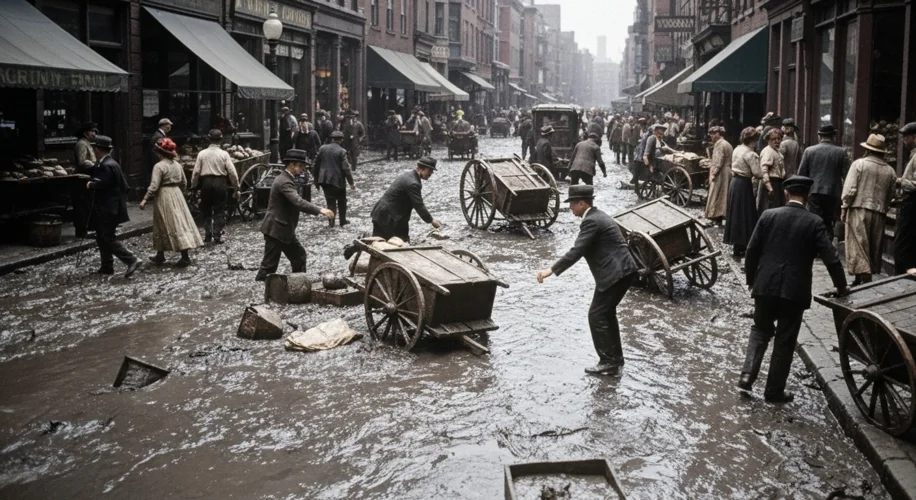The air in Boston’s North End on January 15, 1919, was unusually warm for a mid-January day. Temperatures had climbed rapidly, reaching a balmy 40 degrees Fahrenheit. This unseasonable warmth, however, was about to unleash a disaster of sticky, suffocating proportions.
For years, the Purity Distilling Company had operated a massive storage tank, towering 50 feet high and 50 feet in diameter, on Gibson Street in the heart of the bustling North End. This colossal cylinder held an astonishing 2.3 million gallons of molasses, a dark, viscous product destined for the company’s rum distillery.
The tank, however, was a ticking time bomb. Built hastily in 1915, it was riddled with defects. Rivets leaked, causing a constant drip that locals often collected in buckets, a sweet, sticky testament to the tank’s poor construction. Despite numerous complaints and even a class-action lawsuit filed by residents, the company had done little to address the structural integrity of its enormous container.
On that fateful Tuesday afternoon, around 12:30 PM, the inevitable happened. With a deafening roar that local residents later described as a machine-gun barrage or a colossal clap of thunder, the tank burst apart. An estimated 2.3 million gallons of thick, warm molasses exploded outwards.
It wasn’t like water; it was a tsunami of sticky goo, moving at an estimated 35 miles per hour. The sheer force of the wave was immense, capable of lifting and tossing wagons, ripping buildings from their foundations, and buckling the elevated railway tracks that ran nearby. The dense molasses engulfed everything in its path, trapping people and animals in a suffocating, inescapable embrace.

Eyewitness accounts paint a harrowing picture. “The wave of molasses, from 10 to 25 feet high, swept through the streets,” reported the Boston Globe. “The air was filled with the noise of groaning timbers, crashing masonry, and the cries of the injured.” Horses were found drowned, still strapped to their overturned carts. Buildings were crushed, their contents smashed or buried under the sticky tide. The North End, a densely populated immigrant neighborhood, became a scene of unimaginable devastation.
Rescue efforts were immediate but incredibly challenging. The molasses, still warm from its storage, began to cool and solidify as it spread, making movement agonizingly difficult. Rescuers waded through waist-deep goo, struggling to reach victims. Many who were not killed instantly by the force of the wave suffocated as the thick liquid filled their lungs.
The final toll was devastating: 21 people lost their lives, and over 150 were injured. The cleanup took weeks, with firefighters using hoses to wash the molasses into Boston Harbor, turning the water a peculiar shade of brown.
The aftermath of the Great Molasses Flood led to one of the first major class-action lawsuits in Massachusetts. The investigation revealed the Purity Distilling Company’s gross negligence in maintaining the faulty tank. The company was found liable and forced to pay out substantial damages to the victims and their families.
More than a century later, Bostonians still talk about the Great Molasses Flood. Some claim that on hot summer days, the faint scent of molasses can still be detected in the North End. It serves as a stark, sticky reminder of industrial negligence and the devastating consequences that can arise when profit is prioritized over safety. The sweet syrup that fueled industry had, for one catastrophic moment, become a deadly force, forever etched into the history of Boston.

